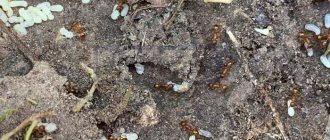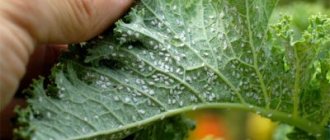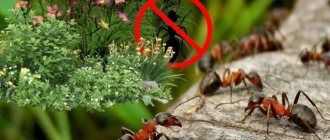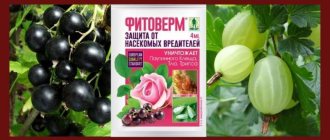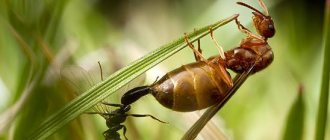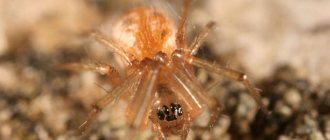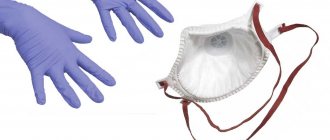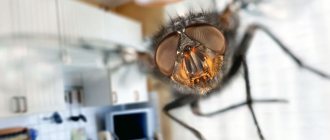Ants are small insects that live in families. One such colony can number up to a million individuals, each of which performs a specific job. The main individual of the family is the queen, thanks to which the population regularly increases. Ordinary worker ants are engaged in obtaining food and water, the search for which forces them to travel long distances. This is what causes them to enter a person’s home. However, flying ants often appear in the house. You can learn about the characteristics of pests and ways to combat them from this article.
Ant flight
In fact, this phenomenon has a completely pragmatic goal: procreation
.
At the beginning of the warm season, new males and females hatch from eggs in wild anthills. But they cannot stay in their native anthill, since an anthill can only have one owner. When the new queens are fully mature, the ant year begins: the queens set out on a journey to meet the males and undergo the fertilization procedure.
It is worth noting that the flight time of ants differs for different species and different climatic conditions.
. The biological clock of ants works in such a way that the queen has time to breed offspring and establish a new colony during the warm and satisfying summer period.
Thus, the year of ants in Russia begins in April and lasts until the beginning of October.
Peculiarities of reproduction of winged ants
Winged ants appear every summer. Those who live in a private house encounter them especially often. With their presence, pests cause great concern to a person, which causes them to be treated accordingly. This may seem strange to some, but such a species as flying ants does not exist in nature.
Interesting!
Ants acquire wings during the mating season, preparing to fly in search of a partner. After a certain time, insects lose them, acquiring their normal appearance. In the photo below you can see what the transparent wing and the flying ant itself look like.
Ants with wings
During fertilization, the male shares his hormones with the female, after which she uses them throughout her life. At the end of the mating process, the male dies or becomes a victim of his relatives. The female is looking for a convenient nest. Moreover, many fertilized females die without having time to find a shelter for themselves. A similar fate befalls those who settle in the wrong place. And only the strongest will be able to say goodbye to their wings and claim the role of queen in the colony.
Is it possible to catch the queen
If you decide to catch a queen yourself to set up a home farm, please note that the winged queens have not yet been fertilized and will not produce brood.
Therefore, if you notice winged queens in a certain place, you can return there a few days later. And find already fertilized, wingless females. You just need to catch them very carefully so as not to damage them.
However, do not forget that wild ants can carry mites, mold spores and pathogens
. Therefore, it is better to order the queen along with the acrylic farm in a specialized store. Unlike a homemade farm, an acrylic formicarium has everything necessary for the full life and development of an anthill.
How to get rid of pests
The question of how to get rid of flying ants in the house will not arise if you maintain order:
- regularly carry out wet cleaning;
- remove crumbs and leftover food from the table;
- use mosquito nets on windows.
If winged ants do get into the house, you can use pesticides and folk remedies to eliminate them.
Chemicals
Insects will not fly around the house if you use effective chemicals. So you can get rid of pests at home using aerosols such as Dichlorvos, Raptor, Clean House or Combat. No less effective for this are gels, the insecticidal composition of which is transferred to the nest by ants on their paws. These include Rubit or Great Warrior.
Important!
However, due to the severe toxicity of these drugs, precautions must be taken using personal protective equipment. After finishing the treatment at home, be sure to thoroughly wash your hands and face.
People's Councils
You can also get rid of flying ants using folk remedies, which are available in every home and are safe, accessible, and also low in price:
- Bait containing yeast, boric acid and jam will have a killing effect on insects. The mixture of these ingredients is spread in a thin layer into small containers.
- Boric acid can be mixed with minced meat and placed in areas where house pests are located.
- The flying ant does not like the smell of garlic.
- Bunches of wormwood, elderberry or mint are no less effective at repelling flying insects. The aromatic oils of these plants will also help get rid of pests.
Anthill structure
The “houses” of these insects are complex and have a surprisingly well-thought-out structure. More than a million individuals can be in it at the same time. The anthill has several exits, each of which is guarded by “soldiers,” as well as a large number of “production” premises.
- There is a “cow barn” - a chamber for keeping aphids (insects that ants breed and protect).
- Cemetery - a compartment for dead insects and various garbage.
- Barns are places for storing supplies. Moreover, there are several types of barns: for “grain” (plant seeds collected by the reapers are stored here) and for “meat”, where caterpillars, flies or other insects brought are stored.
- Place for the uterus. The queen of the colony lives in her own room, her main task is laying eggs. She is cared for by special working individuals.
- Finally, there are chambers with offspring, where larvae, pupae, eggs and workers monitoring them are located.
Indeed, the structure of the insect colony’s home is striking in its logic.
Interesting Facts
Some Indian settlements use goosebumps poison during initiation rites for young men. A bag with insects is put on the hand, they bite, the limb swells and hurts. This is how leaders instill endurance in teenagers.
Ant larvae native to Africa and Asian countries are included in the diet. Larvae are a delicious product; they contain a lot of protein. They also improve potency. Mexicans eat the dish on holidays by spreading eggs on corn tortillas. The queen forming the colony lives 6 years. But a life record of up to 14 years was recorded.
Plant tincture
Garlic tincture to fight ants
Ants often climb onto crops, suck juices from leaves and berries, and leave holes. When attacked by insects, the young plant runs the risk of dying, and the appearance of the formed fruits deteriorates. They repel ants and aphids with a tincture made from wormwood, tansy, mint, garlic, and onion peels.
Pour water over the selected plant, garlic cloves, and onion peels, and leave to infuse for a day. Add laundry soap. The solution is used for spraying garden and vegetable crops, and watering detected anthills.
Exotic varieties
Exotic species of insects often pose a danger to humans. They have difficult behavior.
Bulldog Ants
This type of goose bump is a representative of the tropical fauna. Bulldogs are primitive individuals. They have a lot in common with wasps.
Interesting information! Bulldogs are the largest in the world. Working insects grow up to 3 cm in length. Although the difference in size between the queen and workers is not noticeable, compared to other ants.
Ants are called bulldogs because of their large jaws; they use them to look for food and jump. The larvae themselves eat the food brought by the worker ants. This species is very dangerous. Bulldogs have a sting, and the poisonous substance causes severe allergies, leading to shock.
Leafcutter ants
Amazing view of ants. They have adapted to growing mushrooms, mycelium. They are eaten. The body of the leaf cutter is from 5 mm to 2 cm in length, with a light brown, reddish-brown color. The head is large, has powerful bent jaws, like hooks. The jaws chew out pieces of leaves. The limbs of the leaf cutter are long, adapted to move quickly. The ends of the legs have tenacious hooks, thanks to which leaf cutters climb branches and trunks.
Bullet Ant
Ants live in tropical forests. Tree trunks are used to build nests, camouflaged with branches and leaves. They also prefer soil near the root system. Representatives are dangerous. Goosebump venom is the most toxic insect venom available.
The nickname bullet was given for the impressive size of the sting, up to 3.5 mm, an acute manifestation of pain after a bite, which is comparable to a bullet wound. Insects eat dead and living insects, small vertebrates, cutting them into pieces with their jaws.
Red fiery
The red fire ant is a dangerous and aggressive representative. Every year, 30 people die from a bite. The red ant is small, 2-4 mm. The bite hurts and can cause severe allergies, including anaphylactic shock and death. Houses are built on the ground, forming high hills, throwing clumps of soil to the surface. In urban houses, earth red ants can climb:
- in electrical structures;
- traffic light;
- Appliances.
The fire ant differs from the red forest ant in the presence of several females in the group. This advantage leads to rapid multiplication and spread.
Army
Dangerous species. The body size is from 12 mm to 3 cm, yellow-gray in color. Individuals have sword-like stings, the size of half the body. Army ants are blind and aggressive. Due to blindness, they attack everything that comes in their way.
They called the ants army because a group of 1000 members never sits still. The movement may be suspended when the queen lays her eggs.
Honey
The honey ant has evolved the ability to carry and store honey. In special cells of the nests there are living barrels of honey - these are workers with a large swollen belly. This is how insects stock up on food. Ants live in colonies. The main diet is honeydew.
Yellow Crazy
The unusual name was given to the ants for their erratic behavior. The color of the insects is yellow-brown. Individuals with long limbs and a 4 mm body.
Effective remedies for yellow ants
Interesting information! Goosebumps can spread throughout the world through human transport.
Individuals feed on plants, grain, and invertebrate animals. For people who are not prone to allergic reactions, insects are safe. Although the bite hurts, the bite site itches and swells due to the injected toxic substance.
Tailors
Representatives are observed in tropical and subtropical environments. The color of the tailors is bright green, the paws are beige. The size of worker goosebumps is 8 mm, in males it is 10 mm, and in queens it is 13 mm. To build a house, trees are chosen by connecting the leaves with the help of arachnoid branches of their own larvae. A colony of 500,000 members can be housed in 10 trees.
Where do ants live
These insects are distributed almost all over the world; they are not found only in areas covered with eternal glaciers and in ocean spaces. They learned to amazingly adapt to the most difficult living conditions, even deserts and cold northern regions were no exception.
To build an anthill you can use:
- tree,
- cavity in the ground
- human dwelling.
Sometimes hardworking insects build their own homes. Where ants live depends on their species. For example, blacks prefer to build their homes in the ground or in rotten wood. Redheads make anthills under stones or tree trunks torn out by the wind. Forest people build impressive “mansions” in size, which can be more than 2 meters in height. Pharaohs prefer a humid climate and the proximity of human habitation, so they often become inhabitants of ventilation ducts, spaces behind the baseboards, and even furniture. Individual colonies take over other people's homes.
The largest representatives
Large goosebumps love hot climates, so they can be seen in Africa, South America, and Asia. Individual representatives of large sizes are observed in the forests of Europe.
Camponotus gigas
The largest variety. Goosebumps live in Asia, Thailand, and Malaysia. Individuals with a characteristic color.
- Black body;
- Yellow paws;
- Red-brown color on the back of the body.
The family consists of 8,000 insects. The house underground with the presence of tunnels, chambers, and passages covers about a hectare of soil. Goosebumps nutrition consists of:
- seeds;
- fruit;
- fell;
- bird excrement.
Camponotus vagus
Woodworm goosebumps with a dark gray or black color, body size from 6 to 16 mm. The species chooses sandy soil and forest edges for housing. The mother of the family is the queen. A rotten stump or an area under a stone are the preferred places for an anthill. The family includes up to 10,000 members. The house grows both deep into the soil and above the ground.
Camponotus herculeanus
Externally, woodborers have a black head and belly, and a red sternum. The house is built in soil, rotten wood. One family occupies 1-2 trees. The shelters, which are guarded by soldiers, are connected by a network of passages underground. The red species is organized and active. They attack the victim one by one, but deliver the food they find to the house in an organized manner.
Paraponera clavata
The color of the goose bump is black-brown, grows up to 25 mm. An insect bite is painful. The pain lasts all day, its power is compared to 30 punctures by wasps or bees. The strong effect of the poison affects the motor system and causes convulsions. They feed on living and dead insects and vertebrates. Small families, 10,000 insects. They nest near the root system of trees, delving up to half a meter into the soil.
Dinoponera
Insects settle in dry forests and savannas. The length reaches up to 30 mm; these are predators of large dimensions. Goosebumps eat fish, birds, insects, and amphibians. Goosebumps appear on the surface of the earth when night comes. They attack viciously, bite and drag the prey into the house, where the victim is dismembered. The insects' jaws are razor-sharp.
